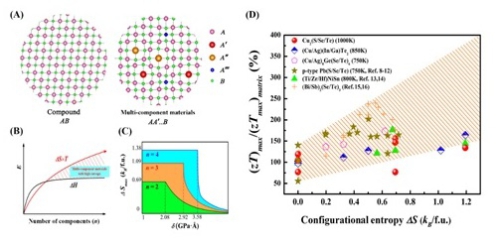
Schematic diagram of multivariate high entropy thermoelectric materials (Figure AC) and optimization of entropy for thermoelectric value of merit ZT (Figure D)

The relationship between lattice distortion energy, system configuration entropy and dissolved element species in multivariate proportional high entropy solution

The relationship between the thermal conductivity (Figure A) and the Seebeck coefficient (Figure B) of the materials in different thermoelectric systems and the entropy value
In recent years, "Material Genetic Engineering", which aims at accelerating the development of materials, has effectively integrated material calculations, material synthesis and characterization, and database technology to quickly identify the key basic factors that determine the performance of materials and achieve scientific "system optimization". The optimization of material properties and the design and exploration of new materials have broken through the traditional way of “experience optimization†characterized by a large amount of experience accumulation and simple trial and error, which has reduced the cycle and cost of material development. Taking thermoelectric energy conversion materials as an example, the traditional research methods involve a large number of structural and compositional optimizations, and the time period is long. Therefore, it is particularly important to adopt the “material genetic engineering†research method.
Recently, researchers from the Shanghai Institute of Ceramics, Chinese Academy of Sciences, Shi Xun, Chen Lidong, and Professor Zhang Wenqing of the Southern University of Science and Technology have proposed the use of "entropy", a basic parameter with similar genetic characteristics, as the performance of thermoelectric materials. Characterizing parameters to achieve rapid screening of multivariate thermoelectric materials, developing models and methods for calculating the entropy of multivariate thermoelectric materials systems, and combining calculations and experiments to screen, design, and validate a series of multicomponent systems and obtain a variety of thermoelectric properties Substantially enhanced multiplex high entropy thermoelectric materials. This work is an important embodiment of the material genetic engineering research method applied to thermoelectric materials, and enriches the research field and content of the concept of "material genetic engineering". Related research was published in Advanced Materials, adma.201702712R2.
In the multivariate thermoelectric material system, the entropy of configuration depends on the type of solution element in the system and its solid solubility. The key to whether it can form a certain type of solid solution and solid solubility is the solid solution and structure of the system. Type-entropy competition. The research team first established a model of elastic mechanics to evaluate the solid solution properties of a series of binary and multivariate thermoelectric material systems, and obtained an intrinsic solution factor d criterion that determines the upper limit of the entropy of the system configuration. According to the criterion, Whether the thermoelectric material system can achieve high entropy solid solution for effective screening, such as Cu2 (S/Se/Te), Heussler alloy multi-element thermoelectric materials can achieve 3 yuan of equal proportion of high entropy solution, diamond-like structure (Cu The (Ag) (In/Ga)Te2 and (Pb/Sn/Ge/Mn)Te compounds can achieve a 4-component high entropy solution.
On this basis, the entropy as a characteristic of similar genes can guide the performance optimization of thermoelectric materials from many aspects such as electron and phonon transport. First, due to the increase of entropy, the structural disorder and distortion in the crystal lattice also increase substantially, which in turn significantly reduces the lattice thermal conductivity. For systems with higher initial thermal conductivity (such as diamond-like compounds), the reduction in entropy-induced thermal conductivity is even more pronounced. Secondly, the increase of entropy leads to the disorderly increase of the local features of the crystal structure, which makes the material have higher macroscopic crystal symmetry, and then increases the degeneracy of the energy band and improves the electrical performance. For example, Cu2(S/Se/Te) matrix compounds have a monoclinic structure at room temperature. After diversifying them to increase the entropy of the material, the crystal structure of the Cu2(S/Se/Te) matrix is ​​transformed into a hexagonal structure with higher symmetry. The Seebeck coefficient is at the same level. The fluent concentration increased by more than 3 times. Based on the above effects, the optimal thermoelectric figure of merit ZT for multi-high entropy diamond-like compounds and Cu2 (S/Se/Te) thermoelectric materials increased to 1.6 and 2.23, respectively.
The research has received funding and support from the National Basic Research Program, the National Key Research and Development Program Material Genome Project, the National Natural Science Foundation, the key deployment projects of the Chinese Academy of Sciences, and major projects of the Shanghai Municipal Science and Technology Commission.
Processed Parts,Processed Machined Parts,Processing Nylon Parts,Processing Custom Parts
Mianyang Prochema Commercial Co.,Ltd. , https://www.gustek.com